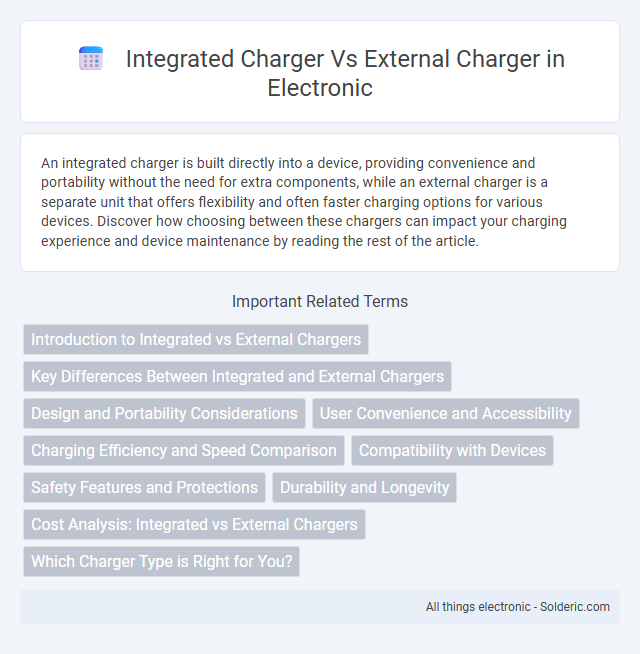An integrated charger is built directly into a device, providing convenience and portability without the need for extra components, while an external charger is a separate unit that offers flexibility and often faster charging options for various devices. Discover how choosing between these chargers can impact your charging experience and device maintenance by reading the rest of the article.
Comparison Table
| Feature | Integrated Charger | External Charger |
|---|---|---|
| Design | Built into the device; compact and streamlined | Separate unit; requires port connection |
| Portability | Highly portable, no extra accessories needed | Less portable, must carry charger separately |
| Charging Speed | Typically moderate speed due to size constraints | Often faster with specialized chargers |
| Heat Management | Limited heat dissipation in device | Better heat control due to separate unit |
| Replacement & Maintenance | Requires device servicing for charger issues | Easy replacement without affecting device |
| Cost | Higher initial device cost | Lower device cost; separate charger purchase |
| Compatibility | Device-specific charger only | Often universal or multi-device compatible |
Introduction to Integrated vs External Chargers
Integrated chargers are built directly into electronic devices, offering convenience, portability, and reduced need for extra components, while external chargers function separately, compatible with multiple devices and often providing faster charging speeds or replaceability. Integrated chargers streamline design and reduce cable clutter but may limit flexibility and require device-specific repairs. External chargers enhance versatility and ease of replacement, especially useful for devices with removable batteries or standardized charging ports like USB-C and Qi wireless charging pads.
Key Differences Between Integrated and External Chargers
Integrated chargers are built directly into devices, offering seamless charging without extra cables or adapters, while external chargers are separate units that require connection to your device via a cable. Integrated chargers provide convenience and portability but may limit flexibility in charging options, whereas external chargers offer versatility, allowing you to use different power sources and replace the charger if needed. Understanding these key differences helps you choose the charging solution that best fits your usage patterns and device compatibility.
Design and Portability Considerations
Integrated chargers offer a sleek, all-in-one design that enhances portability by eliminating the need to carry extra accessories, making them ideal for on-the-go use. External chargers, while bulkier, provide flexibility in replacement and often support faster charging with upgraded components. Your choice depends on whether you prioritize a compact, streamlined device or customizable charging options with potentially better performance.
User Convenience and Accessibility
Integrated chargers enhance user convenience by eliminating the need to carry extra accessories, allowing you to charge devices directly with the built-in system. External chargers offer greater accessibility through universal compatibility, enabling charging multiple devices regardless of brand or model. Choosing between the two depends on whether portability or flexibility best suits your charging needs.
Charging Efficiency and Speed Comparison
Integrated chargers typically offer higher charging efficiency with reduced energy loss due to shorter internal wiring and optimized design, resulting in faster energy transfer directly to the battery. External chargers may experience slight efficiency drops and longer charge times because of external connectors and additional conversion steps. Choosing an integrated charger can enhance your device's charging speed and overall energy efficiency, making it a superior option for quick and reliable power replenishment.
Compatibility with Devices
Integrated chargers are designed specifically for the devices they come with, ensuring seamless compatibility and optimized charging performance. External chargers often offer broader device compatibility through interchangeable tips or adjustable settings, making them versatile for charging multiple gadgets. Your choice depends on whether you prioritize dedicated efficiency or flexible use across various devices.
Safety Features and Protections
Integrated chargers often include built-in safety features like overcharge protection, short circuit prevention, and temperature monitoring, reducing the risk of damage to your device. External chargers may offer advanced protection technologies but rely on external circuitry, which can vary in quality and effectiveness. Choosing an integrated charger can simplify safety management by combining multiple safeguards within a single, compact unit designed specifically for your device.
Durability and Longevity
Integrated chargers generally offer increased durability due to fewer external components exposed to physical damage or environmental factors. External chargers can wear out faster from repeated plugging and unplugging, reducing their overall lifespan compared to integrated units. Quality materials and design in integrated chargers enhance longevity by minimizing connection issues and electrical wear.
Cost Analysis: Integrated vs External Chargers
Integrated chargers typically have a higher initial cost due to built-in components but save on expenses related to additional accessories and installation. External chargers offer lower upfront prices and easier replacement or upgrading options, making them budget-friendly for flexible or evolving charging needs. Your total cost of ownership depends on usage patterns, with integrated solutions providing convenience and reduced clutter, while external chargers allow for greater adaptability and potential savings over time.
Which Charger Type is Right for You?
Integrated chargers offer convenience with built-in power management systems, ideal for those seeking a streamlined, portable solution without extra accessories. External chargers provide versatility and faster charging speeds, perfect for users who prioritize charging efficiency and battery longevity, especially in high-capacity devices. Choosing between integrated and external chargers depends on your device usage patterns, portability needs, and charging speed preferences.
Integrated charger vs external charger Infographic

 solderic.com
solderic.com